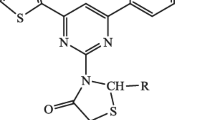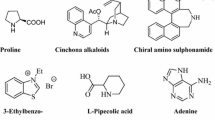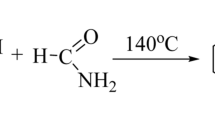Abstract
A series of 6-(N-arylamino)-7-chloro-5,8-quinolinedione derivatives was newly synthesized for the evaluation of antifungal activities. 5-Amino-8-hydroxy-quinoline (II) was treated with KClO3 in HCl to give 6,7-dichloro-5,8-quinolinediones (III). 6-(N-arylamino)-7-chloro-5,8-quinolinediones1–12 were prepared by regioselective nucleophilic substitution of III with arylamines. In the presence of CeCl3, the N-arylamino groups were introduced at the 6-position of 5,8-quinolinedione ring by the regioselective substitution. These derivatives1–12 were tested for antifungal and also antibacterial activities,in vitro, againstCandida albicans, Aspergillus niger, Tricophyton mentagrophytes, Bacillus subtilis, Pseudomonas aeruginosa, Staphylococcus aureus andEscherichia coli. The MIC values were determined by the two-fold agar/streak dilution method. Newly obtained 6-(N-arylamino)-7-chloro-5,8-quinolinedione derivatives showed potent antifungal and antibacterial activities. Among these derivatives,1, 3, 5, 7, 8 and9 showed more potent antifungal activities than fluconazole and griseofulvin. Also most of derivatives were found to be more active than ampicillin against gram-positive bacteria.1 and7 showed the very potent antifungal activities.1 was the most effective in preventing the growth ofCandida albicans, Aspergillus niger, Tricophyton mentagrophytes, Bacillus subtilis andStaphylococcus aureus at MIC 1.6 μg/ml.
Similar content being viewed by others
References Cited
Bowman, C. M., Porter, T. H., Skelton, F. S. and Folkers, K., 5,8-Quinolinequinone analogs which inhibit mitocondrial succinoxidase.J. Med. Chem., 14, 206–209 (1973).
Clark, N. G., The fungicidal activity of substituted 1,4-naphthoquinones.Pestic. Sci., 15, 235–40 (1984).
Cadenas, E. and Ernster, L., Effect of superoxide dismutase on the autoxidation of hydroquinones formed during DT-diaphorase catalysis and glutathione nucleophilic addition: Emerit, I., Packer, L. and Auclair, C. (Eds.),Antioxidants in therapy and preventive medicine-Advances in experimental medicine and biology, Vol. 264, Plenum, New York, 1990, pp. 37–44.
Hafuri, Y., Takemori, E., Oogose, K., Inouye, Y. and Nakamura, S., Mechanism of inhibition of reverse transcriptase by quinone antibiotics.J. Antibiotics, 41, 1471–1478 (1988).
Hassan, H. M. and Fridovich, I., Enzymatic defense against the toxicity of oxygen and of streptonigrin inE. coli.J. Bacterol., 129(3), 1574–1579 (1977).
Hodnet, E. M., Wongweichintana, C., Dunn, W. and Marrs, M., Substituted 1,4-naphthoquinones vs. the ascitic sarcoma 180 of mice.J. Med. Chem., 26, 570–574 (1983).
Inouye, Y., Take, Y., Keiko, O., Kobo, A. and Nakamura, S., The quinolinquione as the minimum entity for reverse transcriptase-inhibitory activity of streptonigrin.J. Antibiotics, 40, 105–109 (1987).
Lin, T. S., Zhu, L. Y., Xu, S. P., Divo, A. and Sartorelli, A., Synthesis and antimalarial activity of 2-aziridinyl-and 2,3-bis-(aziridinyl)-1,4-naphthoquinonyl sulfonate and acylate derivatives.J. Med. Chem., 34, 1634–1639 (1991).
Mcginnis, M. R. and Rindali, M. G., Antifungal drug: Lorian, V. (Eds.),Antibiotics in laboratory medicine, 3rd ed., Williams and Wilkins, Baltimore, 1991, pp. 198–256.
Niels, J. and Wengel, A., Fungicidal activity of 2-(1-alkenyl)-3-hydroxy-1,4-naphthoquinones and related compounds.Pestic. Sci., 17, 686–90 (1986).
Oyanagui, Y. (Eds.),SOD and active oxygen modulatorspharmacology and clinical trials, Nihon-Igakukan, Tokyo, Japan, 1989, pp. 389, 618, 670.
Porter, T. H., Skelton, F. S. and Folkers, K., Synthesis of 5,8-quinolinequinones as inhibitors of coenzyme Q and antimalarials.J. Med. Chem., 14, 1029–1033 (1971).
Pratt, Y. T., Quinolinequinone VI-Reaction with aromatic amines.J. Org. Chem., 27, 3905–3910 (1962).
Pratt, Y. T. and Drake, N. L., Synthesis of 6,7-dichloroquinoline-5,8-quinone.J. Am. Chem. Soc., 82, 1155–1160 (1960).
Rao, K. V. and Beach, J. W., Synthesis and evaluation of some isoquinolin analogues-streptonigrin.J. Med. Chem., 334, 1871–1879 (1991).
Roberts, H., Choo, W. M., Smith, S. C., Marzuki, S., Linnane, A. W., Porter, T. H. and Folkers, K., The site of inhibition of mitochondrial electron transfer by coenzyme Q analogs.Arch. Biochem. Biophys., 191, 306–315 (1978).
Ryu, C. K., Ryu, J. C., Chung, C. Y. and Kim, D. H., Antimicrobial activities of 1,4-naphthoquinone derivatives.Yakhak Hoeji, 36(2), 110–114 (1992).
Ryu, C. K. and Kim, D. M., The synthesis and antimicrobial activities of 1,4-naphthoquinones (II).Arch. Pharm. Res., 15(3), 263–268 (1992).
Ryu, C. K. and Kim, D. H., The some antimicrobial activities of 1,4-naphthoquinones (III).Arch. Pharm. Res., 16(2), 161–163 (1993).
Schellhammer, C. W. and Petersen, S., Derivatives of 5,8-quinolinequinone.Ann. der. Chem., 624, 108–119 (1959).
Take, Y., Sawada, M., Kunai, H., Inouye, Y. and Nakamura, S., Role of the naphthoquinone moiety in the biological activities of sakyomicin A.J. Antibiotics, 39, 557–563 (1986).
Wagner, A., Beck, W. and Diskus, A., Fungicides,Austrian patent, 220, 425–426 (1962);Chem. Abstract, 57, 3420, 9823, 11160 (1962); 56, 4740 (1962).
Wurm, G., Geres, U. and Schmidt, H., Untersuchungen an 1,4-Naphthoquinonen.D. Apotheker Zeitung, 43, 2045–2051 (1980).
Yasuda, M. and Boger, D. L., Streptonigrin and lavandamycin partial structure. A probe for the minimum potent pharmacophore of the antitumor anitibiotics.J. Heterocycl. Chem., 24, 1253–1260 (1987).
Author information
Authors and Affiliations
Rights and permissions
About this article
Cite this article
Ryu, CK., Kim, HJ. The synthesis of 6-(N-Arylamino)-7-chloro-5,8-quinolinedione derivatives for evaluation of antifungal activities. Arch. Pharm. Res. 17, 139–144 (1994). https://doi.org/10.1007/BF02974248
Received:
Issue Date:
DOI: https://doi.org/10.1007/BF02974248




